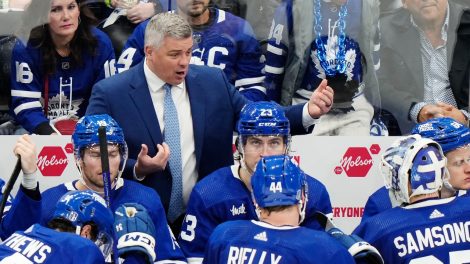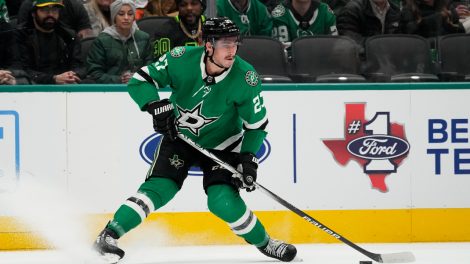It was early in the second period on Monday night, and the Maple Leafs organized a power play breakout against the Minnesota Wild. Dion Phaneuf turned to his left and made a tape-to-tape pass to Tyler Bozak standing at the red line. Bozak accepted the pass and then circled back into the Toronto zone.
Start again.
Bozak then made a pass to Phaneuf on his left, and the Leaf captain relayed the puck to Phil Kessel at the Minnesota blueline. Kessel, also standing still when he accepted the pass, also then circled back into the neutral zone.
By this point, Leaf fans in attendance had to be wondering; exactly what direction are we going in here?
Ultimately, the play ended in an offside on the other side of the ice involving the third member of the line, James van Riemsdyk. Soon, the Leafs No. 1 line was replaced with a makeshift crew that included Zach Sill, Richard Panik and Tim Erixon, and that group produced two good scoring chances.
Mystification all around.
It was just a small sampling in one game, but one that had to produce the same question; what in the world has happened to what was one of the most dangerous lines in hockey back last fall when the Leafs were the highest scoring team in the league?
The answer is, well, a lot. Certainly, much has changed around the Kessel-Bozak-van Riemsdyk trio, and in the process they’ve been reduced to a shadow of their former selves. Collectively, they are minus-102 on the season, a stunningly remarkable stat even in an age when plus-minus isn’t seen to be nearly as important or telling a figure as it once was.
Their fault, or the fault of those around them? Interesting question.
The assumption by many is that the three scoring whizzes turned into duds when Randy Carlyle was fired at the 40-game mark with the team holding a wild card playoff berth and replaced by Peter Horachek for the last 34 games, during which the Leafs have posted a miserable 6-25-3 record and plummeted to 27th overall in the league.
Clearly, the change in coaches, which came with a new emphasis on possession and defensive positioning, didn’t help their production. But for Kessel and Bozak, their struggles seemed to begin before Carlyle was fired. For van Riemsdyk, he actually scored four goals in his first nine games under Horachek, then tailed off.
At this point, all the numbers are ugly:
— In his last 43 games – nine under Carlyle, 34 under Horachek – Kessel has scored just seven goals, or .16 per game. He has scored once in 13 games, and hasn’t scored more than one goal in a game in more than three months.
Before that, he had 17 goals in 31 games, .55 per game, just slightly below his per game average of .59 for the previous three seasons.
— Van Riemsdyk, like Kessel, also has 24 goals in 74 games. But he has just three goals in his last 25 games (.12 per game) after starting the season with 21 in his first 49 (.43 per game), which was actually better than the .38 goals per game he averaged during his first two seasons in Toronto.
— Bozak has 41 pts in 74 games (.55 points per game) after averaging .70 points per game over the previous three seasons. This season has been split into night and day production levels. In his first 37 games, he had 30 points for an average of .81 points per game. In his last 37 games, he has just 11 points (.29 per game). The veteran centre has zero points in his last six games while accumulating a minus-9 rating.
Individually, their seasons have crashed. Collectively, while earning $18.5 million between them, they now look lost and confused as a line, and seem to be growing more so despite the fact that with few options, Horachek seems committed to playing them together and using them at all times with his No. 1 power play unit.
It’s easy to forget the Leafs had a 10-1 streak in November and were at that time the NHL’s No. 1 ranked offence, led by Kessel, Bozak and van Riemsdyk, who were able to collect their points despite being the focal point of the opposition’s checking schemes, as they are now.
So what in the world has happened? Did these guys forget how to play?
For most of Monday’s game against the tight-checking Wild, they looked mostly befuddled. The only Leaf goal was created when Devan Dubnyk couldn’t squeeze a Joffrey Lupul slapshot, and Jake Gardiner poked a loose puck in the crease over the goal line.
Between them, the No. 1 Toronto line had an impressive 12 shots, six by Kessel, but for the most part they weren’t dangerous and until the third failed to attack as a unit, and seemed more like a line that had been hastily thrown together for a game rather than one that has been together for the better part of three seasons.
They all played at least 21:29, but combined for only three hits and one blocked shot. Bozak was a very good 17-11 in the faceoff dot. None had a point, while Bozak and van Riemsdyk were each minus-1. From a possession point-of-view, all three had a positive impact on the stats sheet, certainly much better than their ratings this year would suggest they are on a regular basis.
Given that none are physical or accomplished defensive players, their expressions of effort all come through their finesse games and production. None of the three look particularly confident at the moment, either because they’re struggling or because they find playing in a more structured concept difficult.
Given that this is another lost season in Toronto, the question that may matter more than what has happened to these three players this season is what should be done with them now as the team moves into a rebuilding phase.
Kessel has six years left on his contract with $44 million owing. Bozak has two more years at $4.5 million and $4 million, while van Riemsdyk is scheduled to make $5 million in each of the next two years before hitting unrestricted free agency.
That’s $62.5 million invested in a forward line that, based on the past 30 games or so, is producing offence more like a third line than a first.
The Leafs will have a new head coach next season, and as Barry Trotz demonstrated this season with Alex Ovechkin, a new coach can sometimes have a major impact on the play of a player. If the new Leaf bench boss could get this threesome back to their production levels of the past two or three seasons, it could allow the Leafs to be a better team next season.
Of course, it’s unclear if that’s the objective here. With two first round picks this year and an organizational depth chart that has a few good prospects but not enough of them, the thinking seems to be the Leafs may need to wallow in the bottom of the league for a few seasons before accumulating the kind of young talent that will allow them to eventually work their way back to respectability.
If that’s the case, then having three high-priced attackers on the roster may not be ideal even if they return to their scoring levels of recent seasons.
Could Brendan Shanahan and Co. keep one, or two, members of this unit? What can they get on the open market for any of the three given that Bozak is 29 years old, Kessel is 27 and van Riemsdyk is 25?
Beyond that, Bozak and Kessel are known to be close pals, and there’s a belief that the culture/climate in the Leaf dressing room needs to be altered significantly. Could they stay if captain Dion Phaneuf is moved, or would keeping one or the other allow the player left behind to flourish?
Fascinating questions. What seems true is that all three players are proven NHL offensive talents, and it’s unlikely their talents have evaporated overnight. The team’s new emphasis on analytics might cast them in a different light than outwardly seems to be the case, depending on what metrics Kyle Dubas and others choose to emphasize.
Being part of an organization that seems to have temporarily abandoned trying to win has to be dispiriting, and the team in general is now ranked No. 24 in offence after being the best back in the fall, so they’re not the only ones struggling.
All three have value as assets, with Kessel probably worth the most and Bozak the least, but the Leafs would be selling low at the moment. Moreover, the organization has yet to articulate what the game plan is moving forward. Is it an Edmonton Oilers rebuild? Or is the intent to confound the experts like Calgary did this season and bounce right back into contention for a playoff berth?
And what if, miracle or miracles, the Leafs won the draft lottery and the rights to Connor McDavid? How would that impact decisions?
The answers to some of these questions will start becoming evident in June. For now, the Leafs are left with a big line that’s playing very, very small.










